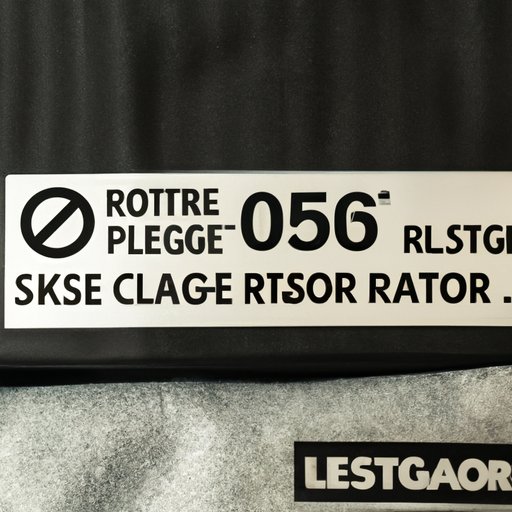Introduction
Traveling is exciting and opens up new possibilities, but figuring out what to pack and how to pack can be stressful. When it comes to traveling with carry-on luggage, the bag size can be a challenge. Understanding airline restrictions and choosing the right size bag can make all the difference in stress-free travel. In this article, we’ll cover everything you need to know about the bag size for carry-on, airline restrictions, and how to pack efficiently.
A Beginner’s Guide to Bag Size for Carry-On: Everything You Need to Know
Carry-on luggage refers to bags that passengers bring into the cabin of the airplane, as opposed to checked luggage that is placed in the cargo hold of the aircraft. When choosing a carry-on bag, there are many types and factors to consider. Common types of carry-on bags include backpacks, duffel bags, and wheeled bags. Consider factors such as size, weight, durability, and features that fit your needs.
As for bag size restrictions, the International Air Transport Association (IATA) sets standards that most airlines follow. The standard size for carry-on luggage is around 22 x 14 x 9 inches (56 x 36 x 23cm), with a maximum weight of 22 pounds (10kg). However, this standard can vary depending on the airline, the class of service you’re flying in, and the destination you’re traveling to.
The Trouble with Carry-On Bag Sizes: A Comprehensive Overview of Airline Restrictions
Each airline has its baggage policies, which include rules and restrictions about the size, weight, and type of carry-on bags allowed on the aircraft. Understanding these rules before heading to the airport can help you avoid frustration, delays, and additional fees.
Some airlines allow larger carry-on bags, while others restrict the size to the IATA standard or even smaller. For example, United Airlines and American Airlines limit carry-on bags to 22 x 14 x 9 inches, while Delta and Southwest Airlines allow bags up to 24 x 16 x 10 inches.
Additionally, some airlines have policies on the type of carry-on bag allowed. For instance, some airlines only allow backpacks or small duffel bags as carry-on, while others permit wheeled bags. It’s best to check the airline’s baggage policy before purchasing a carry-on bag.
How to Choose the Right Carry-On Bag Size for Your Travel Needs
When choosing a carry-on bag, it’s essential to consider several factors. Firstly, consider the length of your trip and the destination. If you’re going on a long trip or to a colder climate, you may need a bigger bag to accommodate bulkier clothing. Secondly, consider your personal preference – do you prefer a backpack, wheeled bag, or duffel bag? Thirdly, think about the features that matter to you, such as pockets, compartments, or durability.
It’s important to note that the size of your carry-on bag isn’t the only determining factor – weight matters too. Choosing a lightweight bag will help you avoid exceeding weight restrictions, and also make it easier to carry and move around.
Top 10 Carry-On Bags that Meet Size Restrictions and Airline Requirements
To help you choose the best carry-on bag, we’ve compiled a list of the top 10 bags that meet size restrictions and airline requirements. These bags come in different styles, sizes, and prices to fit your needs.
- Samsonite Mightlight 2 Softside Spinner 21-inch
- Away The Carry-On
- Travelpro Platinum® Elite 21” Expandable Carry-On Spinner
- Pacsafe Venturesafe X30 Anti-Theft Adventure Backpack
- Tumi Alpha 3 International Expandable Carry-On
- Osprey Farpoint 40 Travel Backpack
- Nomatic 40L Travel Bag
- Victorinox Spectra 2.0 Expandable Global Carry-On
- Incase EO Travel Backpack
- Bric’s MySAFARI in Camel Brown Spinner
Traveling Light: Tips for Packing Efficiently within Carry-On Size Limitations
Packing efficiently is crucial when traveling with a carry-on bag. The goal is to maximize space and minimize weight while still packing all the essentials you need for your trip. Here are some tips for packing efficiently within carry-on size limitations:
- Choose versatile clothing items that can be worn multiple times and paired with different pieces
- Pack toiletries in travel-sized containers
- Use packing cubes to organize and compress clothing items
- Roll clothing instead of folding to save space
- Wear bulky items, such as jackets or boots, during travel
Navigating Carry-On Size Restrictions: A Comparison of Major Airlines’ Policies and Requirements
Navigating carry-on size restrictions can be confusing, as each airline has its own policies and requirements. To help you navigate these restrictions, we’ve compiled a comparison of some major airlines’ policies and requirements:
| Airline | Carry-On Size Limit | Carry-On Weight Allowance | Additional Bag Allowance |
|---|---|---|---|
| Delta | 24 x 16 x 10 inches | None | Personal item |
| United | 22 x 14 x 9 inches | 25 pounds (11kg) | Personal item |
| American | 22 x 14 x 9 inches | 22 pounds (10kg) | Personal item |
| Southwest | 24 x 16 x 10 inches | None | Personal item |
| JetBlue | 22 x 14 x 9 inches | 35 pounds (16kg) | Personal item |
Conclusion
Traveling with carry-on luggage can be a great way to simplify your travel experience and avoid unnecessary fees. Understanding airline restrictions and choosing the right bag size can make all the difference in stress-free travel. Remember to choose a bag that fits your needs, pack efficiently, and always check the airline’s baggage policy before heading to the airport. With these tips and tricks, you’ll be a carry-on luggage expert in no time.


